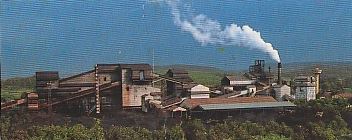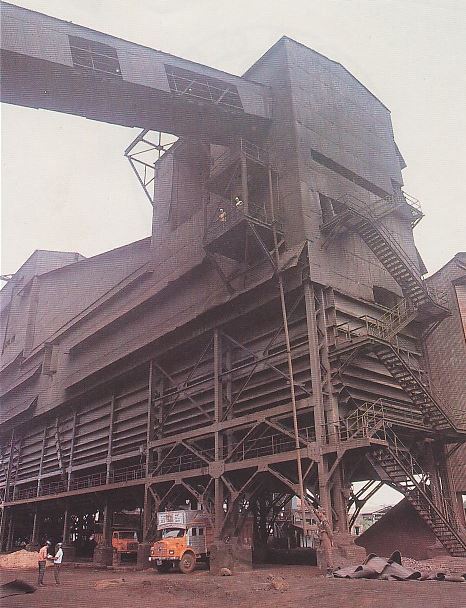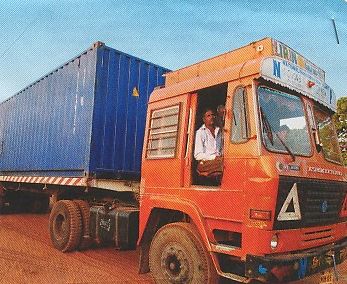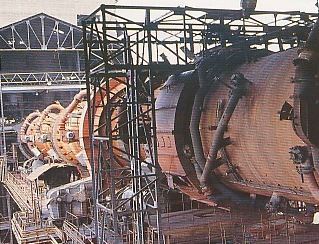





Sponge iron is a product made by direct reduction of iron ore in the presence of coal and lime stone. Gas is also used in place of coal to reduce the iron ore into sponge iron. The oxygen is removed and the ore is converted into more than 90% of metallic content. The sponge iron industries started in India during 1980s. The mini steel plants are depending upon iron and steel scrap for the raw material for steel and steel products. Sponge iron became another source for the raw material for electric furnace and induction furnace. At present around 70% of sponge iron and 30% of scrap is used for raw materials in mini steel plants. So the demand of sponge iron increased due to demand of steel multiplied in the past years. New steel units were established and existing units expanded their capacities. So there is a boom for sponge iron industries in the early part of 21st century
The big steel plants also used up to 30% of raw material as sponge iron in the steel making units. So the demand of sponge iron increased substantially. New sponge iron plants were established and old plants expanded their capacities. At present around 500 sponge iron plants are operating in India. The major concentration of sponge iron units are near the iron ore producing states like Odisha, Jharkhand, Chhattisgarh, Karnataka, Goa, Maharashtra and Tamil nadu. Some sponge iron units are also established in West Bengal and Andhra Pradesh
The present capacity of sponge iron making is around 30 million tones per annum. The total steel production capacity in India is around 65 million tones per annum. The major players of sponge iron production are Essar Steel, Jindal Steel and power Jindal steel works Tata Sponge Iron, Bhusan Steel, Adhunik Metalliks, Maheswari Steel, Jai Balaji Steel and Orissa sponge iron and steel. Other units are medium and small scale in nature. The smaller units produce 30000 tones pre annum sponge iron. The Coal based units are highly polluting and the atmosphere is sprayed with coal and iron ore particles. Around 80% of the units are coal based units. The remaining 20% are gas based units. The gas based units do not pollute the atmosphere like coal based units.
In the last two years there is slow down in the demand of steel, pig iron and sponge iron. Most of the sponge iron units do not have any captive iron ore mines of their own. They purchase iron ores form the public sector mines and private sector mines. The cost of coal, iron ore, dolomite and power increased substantially. The cost of scrap remained stable. The cost of production of sponge iron becomes 20 rupees per Kg. But the market price remains 16 rupees per Kg. The price of sponge iron is guided by the price of iron and steel scrap. The units having captive mines and captive power plants and steel units survived this problem. But the units without captive mines and power plants could not complete in the market. These units without steel units could not manage the cost and the cost of production became higher than the market price. So some units reduced their production level. Some units could not bear the pressure and closed down. The shortage of iron ore, high cost of coal and power and increasing wage hikes put sufficient pressure for closure of some units. The banks are not giving any working capital to the sponge iron units because many of them became defaulter in payment of their previous loans. The pollution controlling authorities also imposed hefty penalties on these polluting units.
All these conditions created very difficult conditions for the sponge iron industries in India. All these units were employing more than one lakh people (both skilled and unskilled). Many people are involved in transportation, loading and un-loading of raw materials and fuel products. New industrial towns developed around these units by providing small marketing points for the local people. The overall economy of the industrial areas improved considerably.
India imports steel and special steel to meet the increasing demand of steel products. China is pushing its steel pig iron and sponge iron with a lower cost to Indian market. The Chinese steel industry is well organized and managed properly. But in India the policy making is chaotic and piece meal basis. Due to mishandling of the textile and edible oil industries in the past, India imports textile and edible oil from other countries. These industries died and many people lost their livelihood. Many entrepreneurs made huge losses and would not recover their investments. Banks could not recover their pending loans. So this was a loss to the country. India spend foreign reserves an import of oil seed, edible oil and textiles. The Government of India declared to increase the steel production and improve the industrial productivity in the country. But one vital segment of the steel industry is at the verge of closure and bankruptcy. Before it is too late the Government of India may intervene and save the sponge iron industry. The units may be provided with cheap iron ore and loans may be granted to them for captive power plants. The coal based units have to be to gas based units. Sufficient gas may provide to the units on reasonable price. The gas supply may be started from Krishna-Godavari gas fields and other gas fields of India. Import of scraps may be restricted and by this activity foreign currencies may be saved. There has to be restriction on the import of mild steel.
The state governments may be asked to take care of the supply of iron ore, power and water to these units. The Government of India must ensure the supply of coal and gas to these units. The major steel plants may be asked to consume some amount of sponge iron in steel making. The metal and mineral trading of India (MMTC) may be declared as nodal agency for marketing of sponge iron produced by these units. Middle man, commission agents and brokers may register under MMTC to facilitate the marking and transportation of sponge iron in India. The banks may be asked to provide working capital loans for day to day for running of the units. The pollution norms are to be relaxed for some time for recovery of the sponge iron units. Three may be a restriction for establishment of new unit in India for the coming 10 years. These measures are to be taken on priority basis to save this sponge industry in India